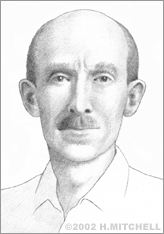Charles Beebe
Charles William Beebe, one of the United States' most significant oceanic pioneers, was born July 29, 1877 in Brooklyn, New York. Having grown up in a family that was very interested in animals and the great outdoors, Beebe was a naturalist early in his life. It was no surprise then, when at 18, a letter he wrote on his observations of the brown creeper was published in Harper's Young People magazine.
Beebe, who grew up in New Jersey, enrolled at Columbia University in 1896. Whether he officially graduated or not is in question, though he never refuted that he earned a BS degree in 1899. That year, he was offered a job as Assistant Bird Keeper at the Zoological Park (now the Bronx Zoo) in New York. He accepted, but the park's director, William T. Hornady, was so impressed with Beebe that he made him Assistant Curator of Birds immediately.
By 1902, Beebe was Full Curator of birds. That year, he married Mary Blair Rice, and the couple traveled to Mexico to study and obtain animal specimens for the park. They published an account of the experience, "Two Bird Lovers in Mexico," in 1905. Later they visited Trinidad and Venezuela and published an account of that voyage as well –"Our Search For a Wilderness."
In 1909, Beebe and his wife accepted an offer to lead an expedition to study pheasants around the world. After a 17-month expedition to the Far East, Beebe published "A Monograph of the Pheasants," a four-volume set. Beebe and his wife were divorced in 1913, and Beebe turned his focus to the tropical jungle. Soon he was named director of the Zoological Park's new Department of Tropical Research.

In 1916, Beebe established the Park's first research station in Kalacoon, British Guiana. He continued to publish accounts of his voyages and his research, including "The Arcturus Adventure" and "Galapagos: World's End." In 1927, Beebe married the writer Elswyth Thane Ricker. He also began helmet diving in the ocean and became interested in the possibility of diving with a deep-sea diving vessel so he could see certain deep-ocean dwelling creatures alive in their natural habitats.
Beebe had discussed the possibilities of deep-sea diving with his good friend and fellow naturalist Theodore Roosevelt. Both men were concerned with the problem of water pressure, knowing that an unprotected diver could be knocked unconscious by the weight of the sea at a depth of just 200 feet. A deeper descent, they knew, could crush a diver to death. They considered various designs for vessels that would enable deep-sea exploration safely. Lacking engineering know-how, however, Beebe sought advice from those who had a greater knowledge of machinery than him.
In 1928, Beebe met and began working with Otis Barton, who had blueprinted a spherical deep sea vessel called a bathysphere, which was a hollow steel sphere at the end of an inch-thick cable. A solid rubber hose carrying telephone wires and electricity for lights would provided divers inside with their only contact with those above water. Beebe agreed to test the vessel, and by 1932, Barton and Beebe were in their third season of bathysphere dives. That year, off the coast of Nonsuch Island, Bermuda, they achieved their world record descent with a half a mile (3,028 feet) dive. That record stood for 15 years. Barton later designed a Benthoscope, which he dove solo in August of 1949 to a depth of 4,500 feet, breaking his own and Beebe's previous record.
Beebe retired from his position as director of the Department of Tropical Research in 1952 at the age of 75. He died in 1962 at age 84. With groundbreaking diving achievements, hundreds of books, articles, and research journals on the natural and oceanic worlds to his credit, he has been regarded by many as the "Jacques Cousteau" of his generation.


